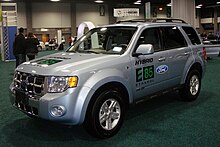Modern HEVs make use of efficiency-improving technologies such as regenerative braking, which converts the vehicle's kinetic energy into battery-replenishing electric energy, rather than wasting it as heat energy as conventional brakes do. Some varieties of HEVs use their internal combustion engine to generate electricity by spinning an electrical generator (this combination is known as a motor-generator), to either recharge their batteries or to directly power the electric drive motors. Many HEVs reduce idle emissions by shutting down the ICE at idle and restarting it when needed; this is known as a start-stop system. A hybrid-electric produces less emissions from its ICE than a comparably-sized gasoline car, as an HEV's gasoline engine is usually smaller than a pure fossil-fuel vehicle, and if not used to directly drive the car, can be geared to run at maximum efficiency, further improving fuel economy.
Types of powertrain
Hybrid electric vehicles can be classified according to the way in which power is supplied to the drivetrain:
In parallel hybrids, the ICE and the electric motor are both connected to the mechanical transmission and can simultaneously transmit power to drive the wheels, usually through a conventional transmission. Honda's Integrated Motor Assist (IMA) system as found in the Insight, Civic Accord, as well as the BAS Hybrid system found in the Chevrolet Malibu hybrids are examples of production parallel hybrids.
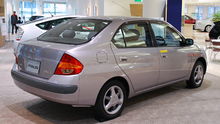
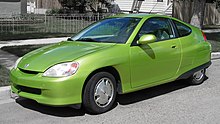

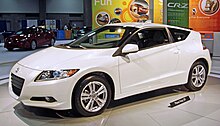
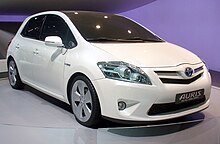


.
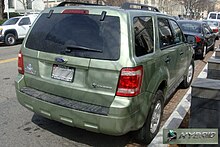
| Top national markets for hybrid electric vehicles between 2007 and 2009 | |||||||
|---|---|---|---|---|---|---|---|
| Rank | Country | Number of registered hybrids 2009 | Percent of global hybrid registrations 2009 | Number of registered hybrids 2008 | Percent of global hybrid registrations 2008 | Number of registered hybrids 2007 | Percent of global hybrid registrations 2007 |
| 1 | 334,000 | 45% | 94,259 | 18% | 69,015 | 14% | |
| 2 | 290,271 | 39% | 312,209 | 61% | 350,289 | 70% | |
| 3 | 16,167(1) | 2% | 15,385 | 3% | 14,828 | 3% | |
| 4 | 13,686(1) | - | 11,814 | 2% | n.a.(2) | - | |
| 5 | 13,661(1) | - | 19,963 | 4% | 15,968 | 3% | |
| Top 5 | - | - | 453,630 | 89% | 457,615 | 91% | |
| World | 740,000 | 511,758 | 500,405 | ||||
| Notes: (1) Cumulative sales until November 2009 only. (2) For year 2007 Netherlands was not among the top 5 world markets. Germany, with 7,515 hybrids sold, was the fifth country in the rank. | |||||||
| Rank 2009 | Metropolitan Area | New registered hybrids per 1000 households (2009) | Rank 2008 | Metropolitan Area | New registered hybrids per 1000 households (2008) |
| 1 | Portland, OR | 8.8 | 1 | Portland, OR | 12.17 |
| 2 | Helena, MT | 6.7 | 2 | San Francisco, CA | 8.84 |
| 3 | San Francisco, CA | 6.7 | 3 | Monterey, CA | 7.16 |
| 4 | Washington, DC | 5.1 | 4 | Santa Barbara, CA | 6.94 |
| 5 | Los Angeles, CA | 4.8 | 5 | San Diego, CA | 6.57 |
| 6 | San Diego, CA | 4.7 | 6 | Los Angeles | 6.08 |
| 7 | Seattle, WA | 4.7 | 7 | Charlottesville, VA | 5.42 |
| 8 | Juneau, AK | 4.6 | 8 | Seattle, WA | 4.90 |
| 9 | Santa Barbara, CA | 4.4 | 9 | Washington, DC | 4.85 |
| 10 | Monterey, CA | 4.3 | 10 | Sacramento, CA | 4.85 |
| U.S. metropolitan area average | 1.8 | U.S. metropolitan area average | 2.1 | ||

